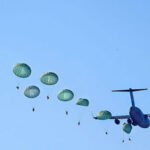After my basic and advanced training at Fort Sill, Oklahoma, it was time for Fort Benning and Jump School. Compared to Fort Sill, Benning was scary. It was the home of infantry training, as well as Jump School and Ranger School. I arrived one week before training was to start. I was introduced to the instructors while we performed guard duty at different areas on the base. The instructors at Jump School are called “Black Hats” because of the black hat that they wear, as opposed to a regular green Army hat. The black hat has their rank and their jump wings on them. The proper way to address the Black Hat is “Clear, Sergeant, Airborne,” or “Not Clear, Sergeant, Airborne.” There is no other way; both terms should be stated in a loud and thunderous voice.
There are three levels of jump wings: basic, with a parachute and wings. Senior jump wings, with a star on top of the parachute, and master jump wings, with a star and wreath around the star. You have to have at least 30 jumps for the senior wings and 65 for the master wings, among other considerations.
Here are a couple of airborne terms:
5 Jump Chump- A person who has successfully completed Jump School, making all 5 jumps and received their wings.
Popping the Cherry- After completing jump school, the first jump in a regular unit, or the 6th jump.
PLF- Parachute Landing Fall- The five points of contact between your body and the ground as you are hitting the ground. They are: 1) the balls of your feet, 2) the calf muscle, 3) the thigh muscle, 4) the buttocks, and 5) the pushup muscle. In that order. Failure that hit the ground in this form will probably put your head into the ground, hard.
Count to Four- After exiting the aircraft, you count to four to ensure that you feel your parachute open. The four count is for the time that it takes the static line (the parachute is connected to the aircraft and opens automatically after a short distance). After four seconds and you do not feel the sharp pull of your parachute opening, you must deploy your reserve chute that is attached to your chest.
Airborne Shuffle- The pace of the runs in the morning, and everywhere you go is at an airborne shuffle, not quite a run, not quite a walk; right in the middle. Beware of the accordion effect. This is when the persons in the back have to slow down, and then sprint back into the formation. This happened quite a bit because the platoon is so big and the pace at the front isn’t always the same.
One major consideration at Jump School is the morning runs. You cannot fall out of two runs in the week, or once on a Friday run; you are kicked out of the training for either of the two above infractions. Falling out means that you are more than two paces behind the runner in front of you. Now, I am not the best runner in the world, but once I got there, I wanted to finish the training. Staying in formation became my number one calling in life. I actually fell to the ground in the second week, and almost got ran over by the platoon behind me. But I got back up and into formation and they did not count that as falling out. Besides that hiccup, I never even came close to falling out of a run.
Every trainee does PLF’s until they are perfect. The downfall is that you do your PLF’s into small woodchips. For the next few weeks after training, you will continue to discover these woodchips coming out of every part of your body, literally.
You move onto the 34-foot towers where you train on exiting the aircraft. This is important because you have to hold your body tight and keep your chin tucked into your chest (so that your helmet doesn’t fall off). This was actually a lot of fun and takes your mind off of the constant PLF training. We also go to do the 250-foot tower once. This was the best seat in the house while you were up there. This is also the best training to work on your real life PLF. You get harnessed into your parachute (with the parachute already opened). The parachute then gets attached to the mechanism that will take you up 250-feet. The ride is a little scary going up, but a lot of fun going down. Your main concern is not hitting the tower (nobody hit the tower during our training).
The airfield seemed like a couple of miles away, and yes, you airborne shuffle there and back. Once you get to the airfield, you see the planes on the tarmac. For us, the plane of choice was the C-130 Hercules. The C-130 is a four-turbo-prop plane that is well liked for its short take off and landing distances, and dependability. We went to the shed to get our parachutes. We used the buddy system to don our equipment and then got checked by the jumpmasters. We could not touch our gear as soon as we were cleared by the jumpmaster. We then waited for our time to get onto the planes.
We got into our “sticks,” or lines, and walked onto the aircraft. We sat in these very small mesh seats and took off. When we were ten minutes away from jumping, the jumpmaster yelled, “Ten Minutes.” We would then in unison, yell, “Ten Minutes, Ten Minutes, Ten Minutes.” We would move from right to left as we said this. Doing this is to ensure that your buddy is awake. If you had a long flight and then you had to jump, this will certainly wake everyone up.
As we got closer, the jumpmaster opened both side doors of the aircraft. The rush of cold December air rushed in, making the excitement that much more. The jumpmaster actually got onto his knees, and leaned out of the door so see below the aircraft (he was making sure that there were no aircraft below us, and no other obstacles that we could hit during our descent). He did this for about one minute and they gave the Air Force Load Master the thumbs up for us to go. The jumpmaster then yelled, “Drop Zone Coming Up, Get Ready.” We again in unison stated, “Get Ready!” The jumpmaster yelled, “Stand Up.” We all stood up. Then “Hook Up!” This was to hook your parachute cord up to the static line. Then “Check Static Lines!” Check your parachute cord to ensure that it is safely connected to the line. Then one more equipment check before you stand in the door. Once you stand in the door, there is only one way off… That is through the door and into the wind. One master sergeant got to the door and froze. The jumpmaster put a foot in the butt of the master sergeant and out the door she went.
Once airborne, you count to four loudly. You should feel the pull of the parachute opening. You should then enjoy the ride for a couple of seconds before you have to prepare for the PLF’s that you have been practicing. On my third jump, I didn’t tuck my chin enough to my chest. My Kevlar helmet fell off and I landed without the helmet. A Black Hat quickly came up to me and was yelling at me. A couple of minutes later, another Black Hat came by with my helmet and yelled at me some more. Note to self, tuck in your chin, stupid.
All through the whole experience of jumping, the only things that I thought about was everything that could go wrong. The Black Hats educated us on the different malfunctions that you could have and how to overcome them. An example is what if your parachute doesn’t open. They tell you to quickly pull your reserve parachute. Luckily, this 5 Jump Chump didn’t have too many problems. Because we were already several days late to due bad weather, my wings got pinned on in an informal ceremony after our fifth jump. The wings are beautiful and I wore them proudly during my time in the military. I would suggest anyone who is going in the Army, go to Jump School, you will never forget it!





